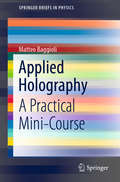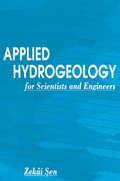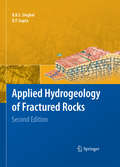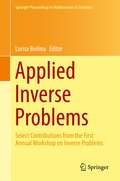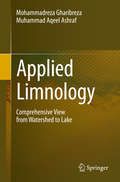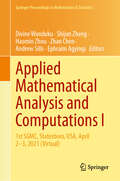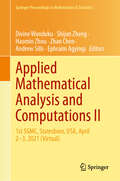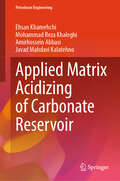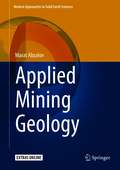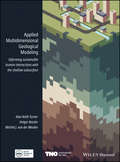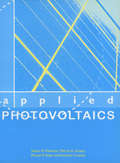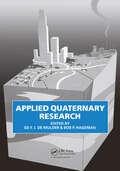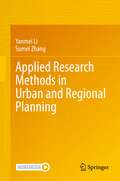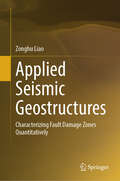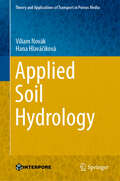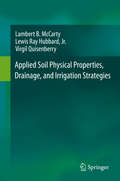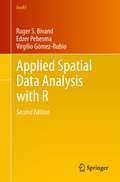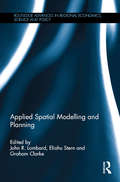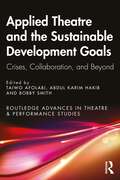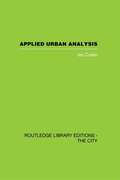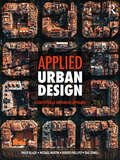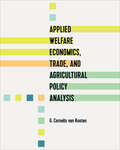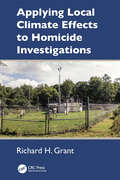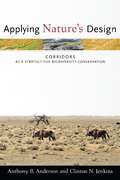- Table View
- List View
Applied Holography: A Practical Mini-Course (SpringerBriefs in Physics)
by Matteo BaggioliThis primer is a collection of notes based on lectures that were originally given at IIT Madras (India) and at IFT Madrid (Spain). It is a concise and pragmatic course on applied holography focusing on the basic analytic and numerical techniques involved. The presented lectures are not intended to provide all the fundamental theoretical background, which can be found in the available literature, but they concentrate on concrete applications of AdS/CFT to hydrodynamics, quantum chromodynamics and condensed matter. The idea is to accompany the reader step by step through the various benchmark examples with a classmate attitude, providing details for the computations and open-source numerical codes in Mathematica, and sharing simple tricks and warnings collected during the author’s research experience. At the end of this path, the reader will be in possess of all the fundamental skills and tools to learn by him/herself more advanced techniques and to produce independent and novel research in the field.
Applied Hydrogeology for Scientists and Engineers
by Zekai SenIn order to properly plan, design, and operate groundwater resources projects, it is necessary to measure - over time or distance - pertinent groundwater variables such as drawdown and discharge in the field. Applied Hydrogeology for Scientists and Engineers shows how to assess and interpret these data by subsurface geological setup and processing. The book helps readers estimate relevant groundwater parameters such as storativity, transmissivity, and leakage coefficient.The text addresses many interrelated disciplines such as geology, hydrology, hydrogeology, engineering, petroleum geology, and water engineering. Traditional and current models for application are presented. One of the unique features of the book is the inclusion of new and previously unpublished ideas, concepts, techniques, approaches, and procedures developed by the author. Among these are hydrogeophysical concepts, slope matching techniques, volumetric approach solution for complicated groundwater flows, non-Darcian flow law applications, aquifer sample functions, dimensionless-type straight line methods, non-linear flow-type curves, discharge calculations from early time-drawdown data, storage coefficient estimation procedure for quasi-steady state flow, and much more. The pitfalls in aquifer test analysis are also detailed. Fractured medium flow adds yet another dimension to the book. Each method is supplemented by actual field data applications from worldwide case studies.Applied Hydrogeology for Scientists and Engineers covers the topics of groundwater reservoirs, the evaluation of aquifer parameters, aquifer and flow properties, flow properties and bore hole tests, aquifer tests in porous and fractured media, well hydraulics, groundwater flow and aquifer tests, and field measurements and their interpretations.This new reference also works well as a post-graduate textbook on the subject. Applied Hydrogeology for Scientists and Engineers expands the reader's knowledge by providing valuable information not found in any other publication.
Applied Hydrogeology of Fractured Rocks: Second Edition
by B.B.S. Singhal † R. P. GuptaHydrogeology is a topical and growing subject as the earth's water resources become scarcer and more vulnerable. More than half of the surface area of continents is covered with hard rocks of low permiability. This book deals comprehensively with the fundamental principles for understanding the hydrogeological characteristics of rocks, as well as exploration techniques and assessment. It also provides in depth discussion on structural mapping, remote sensing, geophysical exploration, GIS, groundwater flow modelling and contaminant transport, field hydraulic testing including tracer tests, groundwater quality, geothermal reservoirs, managed aquifer recharge, and resources assessment and management. Hydrogeological aspects of various lithology groups, including crystalline rocks, volcanic rocks, carbonate rocks and clastic formations have been dealt with separately, using and discussing examples from all over the world. It will be an invaluable text book cum reference source for postgraduate students, researchers, exploration scientists and engineers engaged in the field of groundwater development in fractured rocks. Applied Hydrogeology of Fractured Rocks - Second Edition is thoroughly revised and extended with a new chapter, updated sections, many new examples, and expanded and updated references.
Applied Inverse Problems: Select Contributions from the First Annual Workshop on Inverse Problems (Springer Proceedings in Mathematics & Statistics #48)
by Larisa BeilinaThis proceedings volume is based on papers presented at the First Annual Workshop on Inverse Problems which was held in June 2011 at the Department of Mathematics, Chalmers University of Technology. The purpose of the workshop was to present new analytical developments and numerical methods for solutions of inverse problems. State-of-the-art and future challenges in solving inverse problems for a broad range of applications was also discussed. The contributions in this volume are reflective of these themes and will be beneficial to researchers in this area.
Applied Limnology: Comprehensive View from Watershed to Lake
by Muhammad Aqeel Ashraf Mohammadreza GharibrezaA multidisciplinary study of Bera Lake in Malaysia is presented here, focusing on natural resources throughout the lake's catchment area and assessing environmental impact. This applied limnology study examines issues relating to land development including soil erosion and nutrient loss in the catchment area, severe pollution of water, sediment resources in open waters and wetlands, and reduction of aquatic and bird populations. The chapters provide a comprehensive view of problems, risks and possible mitigation measures associated with this great natural habitat. The book highlights the technology and methods used to estimate both soil erosion rate and nutrient loss from the lake catchment, including an explanation of the measurement of the sedimentation rate in Bera Lake using 137Cs and 210Pb radioisotopes. The author examines the current and historic situation of contamination in sediments, presents an ecological risk assessment, and finally describes a master management plan, proposing practices to mitigate the environmental impacts of existing agricultural projects and practices to control future projects. Readers will learn of a decrease in the watershed supply of water to Bera Lake, of shoaling, degradation of water and sediment quality, and the extinction of several kinds of flora and fauna. This volume also offers an approach to sustainable land use with regard to natural resources conservation.
Applied Mathematical Analysis and Computations I: 1st SGMC, Statesboro, USA, April 2–3, 2021 (Virtual) (Springer Proceedings in Mathematics & Statistics #471)
by Divine Wanduku Shijun Zheng Haomin Zhou Zhan Chen Andrew Sills Ephraim AgyingiThis volume convenes selected, peer-reviewed research and survey articles that address the modern state-of-the-art in varied areas of applied mathematical analysis. They primarily include presentations as well as invited contributions for the 1st Southern Georgia Mathematics Conference (SGMC) that was virtually held on April 2—3, 2021 at the Georgia Southern University, Statesboro, USA. Papers in this volume incorporate both advanced theory and methods from mathematical analysis, and cover myriad topics like imaging and inverse problems, evolutionary PDEs, symbolic computation, dynamics and data analysis, data science, computational mathematics, and more. This first volume focuses on mathematical analysis theory and applications. These studies and findings contained herein will be of interest to researchers and graduate students working in the fields of mathematical analysis, modeling, data analysis and computation, with applications in many interdisciplinary applied sciences, as in statistics, physics, biology, and medical imaging. They are particularly relevant to those at the forefront of applied mathematical and statistical analysis, as well as data science and other computational science disciplines. In its first edition, the Southern Georgia Mathematics Conference brought together 74 speakers from 70 different institutions, from the USA, Canada, Austria, and Botswana. Attendees included faculty, researchers, experts, graduate and undergraduate students from all over the world.
Applied Mathematical Analysis and Computations II: 1st SGMC, Statesboro, USA, April 2–3, 2021 (Virtual) (Springer Proceedings in Mathematics & Statistics #472)
by Divine Wanduku Shijun Zheng Haomin Zhou Zhan Chen Andrew Sills Ephraim AgyingiThis volume convenes selected, peer-reviewed research and survey articles that address the modern state-of-the-art in varied areas of applied mathematical analysis. They were presented at the 1st Southern Georgia Mathematics Conference (SGMC) that was virtually held on April 2—3, 2021, at Georgia Southern University, Statesboro, USA. Papers in this volume incorporate both advanced theory and methods from mathematical analysis and cover myriad topics such as imaging and inverse problems, evolutionary PDEs, symbolic computation, dynamics and data analysis, data science, computational mathematics, and more. This second volume focuses on modeling, simulation and data analytical studies in the field of computational mathematics. These studies and findings contained herein will be of interest to researchers and graduate students working in the fields of mathematical analysis, modeling, data analysis, and computation, with applications in many interdisciplinary applied sciences, including statistics, physics, biology, and medical imaging. They are particularly relevant to those at the forefront of applied mathematical and statistical analysis, as well as data science and other computational science disciplines. In its first edition, the Southern Georgia Mathematics Conference brought together 74 speakers from 70 different institutions, including the USA, Canada, Austria, and Botswana. Attendees included faculty, researchers, experts, graduate, and undergraduate students from all over the world.
Applied Matrix Acidizing of Carbonate Reservoir (Petroleum Engineering)
by Ehsan Khamehchi Mohammad Reza Khaleghi Amirhossein Abbasi Javad Mahdavi KalatehnoThis book enhances readers’ understanding of matrix acidizing and its pivotal role in the oil and gas industry. It is a comprehensive guide to maximizing reservoir performance. The book explores carbonate reservoirs, where acid meets rock, and indicates pathways to increased well productivity. Based on extensive research, the book has insights for students, professionals, and researchers and all those interesting in realizing the full potential of oil and gas reservoirs.
Applied Mining Geology (Modern Approaches in Solid Earth Sciences #12)
by Marat AbzalovThis book provides a detailed overview of the operational principles of modern mining geology, which are presented as a good mix of theory and practice, allowing use by a broad range of specialists, from students to lecturers and experienced geologists.The book includes comprehensive descriptions of mining geology techniques, including conventional methods and new approaches. The attributes presented in the book can be used as a reference and as a guide by mining industry specialists developing mining projects and for optimizing mining geology procedures. Applications of the methods are explained using case studies and are facilitated by the computer scripts added to the book as Electronic Supplementary Material.
Applied Multidimensional Geological Modeling: Informing Sustainable Human Interactions with the Shallow Subsurface
by A. Keith TurnerOver the past decades, geological survey organizations have digitized their data handling and holdings, unlocking vast amounts of data and information for computer processing. They have undertaken 3-D modeling alongside, and in some cases instead of, conventional geological mapping and begun delivering both data and interpretations to increasingly diverse stakeholder communities. Applied Multidimensional Geological Modeling provides a citable central source that documents the current capabilities and contributions of leading geological survey organization and other practitioners in industry and academia that are producing multidimensional geological models. This book focuses on applications related to human interactions with conditions in the shallow subsurface, within 100-200 m of the surface. The 26 chapters, developed by 100 contributors associated with 37 organizations, discuss topics relevant to any geologist, scientist, engineer, urban planner, or decision maker whose practice includes assessment or planning of underground space.
Applied Photovoltaics
by Richard Corkish Martin A Green Muriel E Watt Stuart R WenhamA reliable, accessible and comprehensive guide for students of photovoltaic applications and renewable energy engineering. This thoroughly considered textbook from a group of leading influential and award-winning authors is brimming with information and is carefully designed to meet the needs of its readers. Along with exercises and references at the end of each chapter, the book features a set of detailed technical appendices that provide essential equations, data sources and standards. Starting from basics with 'The Characteristics of Sunlight' the reader is guided step-by-step through semiconductors and p-n junctions; the behaviour of solar cells; cell properties ad design; and PV cell interconnection and module fabrication. The book covers stand-alone photovoltaic systems; specific purpose photovoltaic systems; remote are power supply systems; and grid-connected photovoltaic systems. There is also a section on photovoltaic water pumping system components and design. Applied Photovolatics is well illustrated and readable with an abundance of diagrams and illustrations, and will provide the reader with all the information needed to start working with photovoltaics.
Applied Quaternary Research
by ED F.J.DE MULDER Bob P. HagemanProceedings of a symposium at the 1987 INQUA Congress, Ottawa, Aug. 1987. Contributions present the application of quaternary studies to land use planning and development. No index. Annotation copyright Book News, Inc. Portland, Or.
Applied Research Methods in Urban and Regional Planning
by Yanmei Li Sumei ZhangThis book introduces the fundamentals of research methods and how they apply to the discipline of urban and regional planning. Written at a level appropriate for upper-level undergraduate and beginning master’s level students, the text fills a gap in the literature for textbooks on urban planning. Additionally, the book can be used as a reference for planning practitioners and researchers when analyzing quantitative and qualitative data in urban and regional planning and related fields.The volume does not assume advanced knowledge of mathematical formulas. Rather, it begins with the essentials of research methods, such as the identification of the research problems in planning, the literature review, data collection and presentation, descriptive data analysis, and report of findings. Its discipline-specific topics include field research methods, qualitative data analysis, economic and demographic analysis, evaluation research, and methods in sub-disciplines such as land use planning, transportation planning, environmental planning, and housing analysis. Designed with instruction in mind, this book features downloadable materials, including learning outcomes, chapter highlights, chapter review questions, datasets, and certain Excel models. Students will be able to download review questions to enhance the learning process and datasets to practice methods.
Applied Seismic Geostructures: Characterizing Fault Damage Zones Quantitatively
by Zonghu LiaoThis book focuses on the characterization of fault damage zones and subsurface structure systems quantitatively for the first time. It provides a comprehensive case study of various types of fault damage zones, including normal, reverse, strike-slip, and composite zones. The book also explores fractures within fault damage zones and the effect of faulting on cap rock integrity. Through meticulous case studies and analyses from diverse geographical regions, this book elucidates the seismic characteristics and behaviors associated with fault damage zones. Readers will find particular interest in the methods and results presented in the book, as it offers a holistic and systematic approach to understanding and building seismic geostructures. Incorporating seismic attributes and coherence analysis, as well as applying neural networks, it provides readers with innovative techniques in fault characterization and segmentation. Besides, this book incorporates illustrative visuals, insightful tables, and cutting-edge seismic attributes, which enhance the reader's understanding of the subject matter. Researchers, professionals, and students in petroleum geology, geophysics, and engineering will find this book to be an invaluable resource with the practical insights and innovative methodologies it offers for the state-of-the-art characterizing and analyzing fault damage zones.
Applied Soil Hydrology (Theory and Applications of Transport in Porous Media #32)
by Viliam Novák Hana HlaváčikováThis state-of-the-art book clearly explains the basic principles of soil hydrology and the current knowledge in this field. It particularly highlights the estimation and application of measurements and evaluation of soil-hydrophysical characteristics using simulation models, with a focus on elucidating the basic hydrophysical characteristics of soil, such as soil water potential and hydraulic conductivity, as well as the methods of measurement. It also addresses topics such as stony soil, water repellent soils, and water movement modeling in those media. The book presents soil hydrology in a simple way, while quantitatively expressing the soil water state and movement. It clearly and precisely describes basic terms of soil hydrology with a minimum of mathematics. It also includes the latest research findings in the field as well as the basics of the mathematical modeling of water movement in the soil-plant-atmosphere system (SPAS), using original research results to illustrate these issues.This book is of interest to all scientists and professionals in soil hydrology, including beginners, as well as those interested and working in hydrology in general and soil hydrology in particular. In addition, it can also be used by specialists and students in related fields like agronomy, forestry, meteorology, hydrology, environmental engineering, environmental protection, and geography.
Applied Soil Physical Properties, Drainage, and Irrigation Strategies.
by Lambert B. Mccarty Lewis Ray Hubbard Jr. Virgil QuisenberryThe book is a realistic blend of basic knowledge and understanding in soil physical properties. It will enable the reader to scientifically analyze soils to develop practical and successful means of providing sufficient drainage and to develop science-based irrigation strategies. Only basic mathematical knowledge is necessary to understand and apply the proven principles covered. With limited resources that are increasing significantly in costs, the book blends the ideal concept of providing sufficient drainage and irrigation based on using soil physical properties but with financial limitations in mind. One traditional problem with many Soil Physics, Drainage, and Irrigations-based texts is the prerequisite of understanding complicated calculus-based mathematics. Although necessary for a theory-based text, our text was developed with practitioners in mind where such complicated mathematics was avoided but referenced if the reader wishes to further explore the specific topic. Another problem with many traditional texts is the lack of practical examples or case-studies allowing readers to relate their specific scenarios to similar types of situations. We have purposely included numerous examples and practical field experiences. This is especially true when many of the theoretical ideals are covered, followed by explanations of how such ideals can be applied in the laboratory and field.
Applied Spatial Data Analysis with R (Use R! #10)
by Virgilio Gómez-Rubio Roger S. Bivand Edzer PebesmaApplied Spatial Data Analysis with R, second edition, is divided into two basic parts, the first presenting R packages, functions, classes and methods for handling spatial data. This part is of interest to users who need to access and visualise spatial data. Data import and export for many file formats for spatial data are covered in detail, as is the interface between R and the open source GRASS GIS and the handling of spatio-temporal data. The second part showcases more specialised kinds of spatial data analysis, including spatial point pattern analysis, interpolation and geostatistics, areal data analysis and disease mapping. The coverage of methods of spatial data analysis ranges from standard techniques to new developments, and the examples used are largely taken from the spatial statistics literature. All the examples can be run using R contributed packages available from the CRAN website, with code and additional data sets from the book's own website. Compared to the first edition, the second edition covers the more systematic approach towards handling spatial data in R, as well as a number of important and widely used CRAN packages that have appeared since the first edition. This book will be of interest to researchers who intend to use R to handle, visualise, and analyse spatial data. It will also be of interest to spatial data analysts who do not use R, but who are interested in practical aspects of implementing software for spatial data analysis. It is a suitable companion book for introductory spatial statistics courses and for applied methods courses in a wide range of subjects using spatial data, including human and physical geography, geographical information science and geoinformatics, the environmental sciences, ecology, public health and disease control, economics, public administration and political science. The book has a website where complete code examples, data sets, and other support material may be found: http://www.asdar-book.org. The authors have taken part in writing and maintaining software for spatial data handling and analysis with R in concert since 2003.
Applied Spatial Modelling and Planning (Routledge Advances in Regional Economics, Science and Policy)
by John R. Lombard, Eliahu Stern and Graham ClarkeThis book highlights the extraordinary range of areas to which geographical analysis and spatial modelling can bring lessons and insights. It shows how these techniques have been used to address ‘real world’ issues that are of concern to international organisations, public agencies and businesses, as illustrated by actual funded projects that geographers have developed collaboratively with end-users. Applied Spatial Modelling and Planning shows how much geographical research is policy relevant to a wide variety of agencies through the use of GIS and spatial modelling in applied geography. The book’s chapters contain a cross-section of innovative applications and approaches to problem solving within five major domains of the dynamics of economic space, housing and settlements, population movements and population ageing, health care, and the environment. Using a number of case studies on the use of GIS and spatial modelling, this book demonstrates the fact that much of what is done by quantitative geographers is not only relevant within academia, but also has use in policy work. This book will appeal to an international audience interested in cutting-edge spatial modelling to better understand the processes involved in solving real problems.
Applied Theatre and the Sustainable Development Goals: Crises, Collaboration, and Beyond (ISSN)
by Bobby Smith Taiwo Afolabi Abdul Karim HakibThis book is the first definitive publication to consider the intersections of applied theatre and the Sustainable Development Goals (SDGs) – a series of goals which have shaped development and social justice initiatives from 2015 to 2030.It brings together emerging and leading scholars and practitioners engaged in creative and community contexts globally. In so doing, the book offers critical insights to explore the convergences, complexities, and tensions of working within development frameworks, through theatre. Divided into three thematic areas, it maps out the ways in which applied theatre has related to the SDGs, examines issues with global collaborations, and, as 2030 approaches and the SDG era draws to a close, interrogates such practices, envisioning what the role of applied theatre might be in the post-SDG era. The book provokes reflection about this specific era of applied theatre and global development, as well as discussion regarding what comes next.This volume will be of importance to students, artists, scholars, practitioners, and policymakers working in applied theatre and the field of development.
Applied Thermodynamics for Meteorologists
by Miller SamThis textbook on atmospheric thermodynamics is for students of meteorology or atmospheric science. It also serves as a reference text for working professionals in meteorology and weather forecasting. It is unique because it provides complete, calculus-based derivations of basic physics from first principles, and connects mathematical relationships to real-world, practical weather forecasting applications. Worked examples and practice problems are included throughout.
Applied Urban Analysis: A critique and synthesis
by Ian CullenMuch of the theoretical literature in planning and human geography at present is materialist in perspective. This offers a powerful critique but locates the dynamics of urban systems too specifically in just one basic social relationship. It fails to provide an intellectual base broad enough for constructive, detailed urban analysis, partly because it fails to do justice to the reflective awareness of the individual. The alternative humanist position redresses the balance in favour of the individual but again cannot serve the practical requirements of urban analysis since it so often ignores social or contextual analysis. Ian Cullen synthesizes these tow apparently inconsistent theoretical positions and to render the increasingly obscure debate between them accessible. This book was first published in 1984.
Applied Urban Design: A Contextually Responsive Approach
by Michael Martin Robert Phillips Philip Black Taki SonbliApplied Urban Design combines 'why' we design and 'who' we design for, with 'how' we design, by providing the reader with a comprehensive and accessible bespoke framework for both understanding and practicing urban design in a contextually responsive manner from appraisal to design delivery. The framework is presented across four distinct steps, covering analysis at strategic and local scales; the urban design program; design development; and technical design. The authors unpack the functional blueprints, liveable qualities, contextual dynamics, and technical components of quality urban design, identifying the role of urban designers in shaping spaces and places across differing local contexts through a responsive and multiscalar approach. International best practice examples and two original ‘live’ case studies in Aalborg, Denmark and Manchester, UK demonstrate the application of the framework across differing scales and contexts – each supported by authors own images and graphics that illustrate the broad range of urban design visualisation techniques and methods.Visually compelling and insightful, Applied Urban Design is for all who seek to understand, demand, and create people-centred, high-quality, contextually responsive places and spaces.
Applied Welfare Economics, Trade, and Agricultural Policy Analysis
by G. Cornelis van KootenThis textbook integrates three related fields in economics, namely agricultural/forestry economics, environmental economics, and international trade, by foregrounding cost-benefit analysis as a significant policy tool. Exploring how welfare measures can be used in the analysis of agricultural, trade, and other economic policies, Applied Welfare Economics, Trade, and Agricultural Policy Analysis fills a gap in the literature on agricultural policy analysis by explaining the economic efficiency improvements and income transfers of various agricultural policy reforms in the United States, Canada, and the European Union. G. Cornelis van Kooten addresses methods of identifying and measuring economic surpluses (costs and benefits), the precautionary principle, identification of an appropriate discount rate, the importance of nonmarket values, and the role of agriculture in trade negotiations and climate change. Applied Welfare Economics, Trade, and Agricultural Policy Analysis draws on new research, brings attention to the existing literature, and includes review questions at the end of each chapter. The techniques developed in this text can be applied to the development and reform of agricultural policies in various regions.
Applying Local Climate Effects to Homicide Investigations
by Richard H. GrantApplying Local Climate Effects to Homicide Investigation presents the concepts behind using local climate and weather records to enhance understanding of criminal cases. While sources of such local climate and weather information varies by country and regions, weather conditions are typically measured at airports or grassy areas as part of a national, regional, or state-wide networks using many different instruments.The information derived from such instruments and weather reporting services and agencies can inform and impact investigations, especially in the case of natural death or homicide cases. The determination of post-mortem interval (PMI) in homicide cases is often based on entomological or anthropological evidence in combination with local climate estimations. Determining the local climate conditions typically requires knowledge of the environmental conditions where the body is found and the conditions where the measurement record was made. Most people recognize that cities are hotter than the surrounding countryside and that lake and coastal shorelines are cooler than fields: all of these comprise local climates. The local climate where a corpse is discovered usually differs from where temperature and humidity measurements are made. Consequently, many investigators and forensic pathologists do not realize the influence that such local temperatures and humidity can have on post-mortem interval determinations.The book focuses on local climate conditions associated with the determination of post-mortem interval (PMI) and gives concepts behind adjusting climate information for local climates at the corpse. In addition, the book will present guidelines for crime scene investigators and lawyers to determine whether or not expert consultation is needed, and whether or not on-site measurements are needed. Most importantly, this book presents tools (data sources and modeling approaches) to guide forensic climatologists conducting forensic climatology work. It offers a basic, working understanding of the influence of the local environment on the local climate for forensic entomologists, forensic anthropologists, crime scene investigators, and lawyers. Numerous case studies are included throughout to show approaches, illustration decision points, and provide an understanding of the various impacts of regional and micro-climates upon decedents and their remains.
Applying Nature's Design: Corridors as a Strategy for Biodiversity Conservation (Issues, Cases, and Methods in Biodiversity Conservation)
by Anthony Anderson Clinton JenkinsThe fragmenting of habitats is endangering animal populations and degrading or destroying many plant populations throughout the world. To address this problem, conservationists have increasingly turned to biological corridors, areas of land set aside to facilitate the movement of species and ecological processes. However, while hundreds of corridor initiatives are under way worldwide, there is little practical information to guide their design, location, and management. <P><P>Applying Nature's Design offers a comprehensive overview of current knowledge on corridors, their design, and their implementation. Anthony B. Anderson and Clinton N. Jenkins examine a variety of conceptual and practical issues associated with corridors and provide detailed case studies from around the world. Their work considers how to manage and govern corridors, how to build support among various interest groups for corridors, and the obstacles to implementation. In addition to assessing various environmental and ecological challenges, the authors are the first to consider the importance of socioeconomic and political issues in creating and maintaining corridors.
